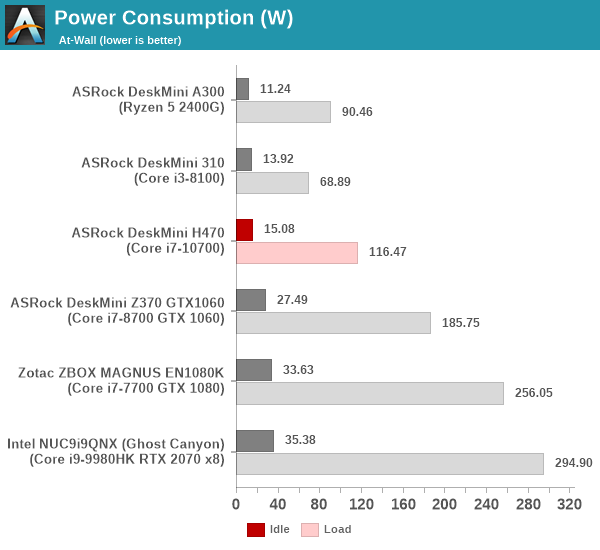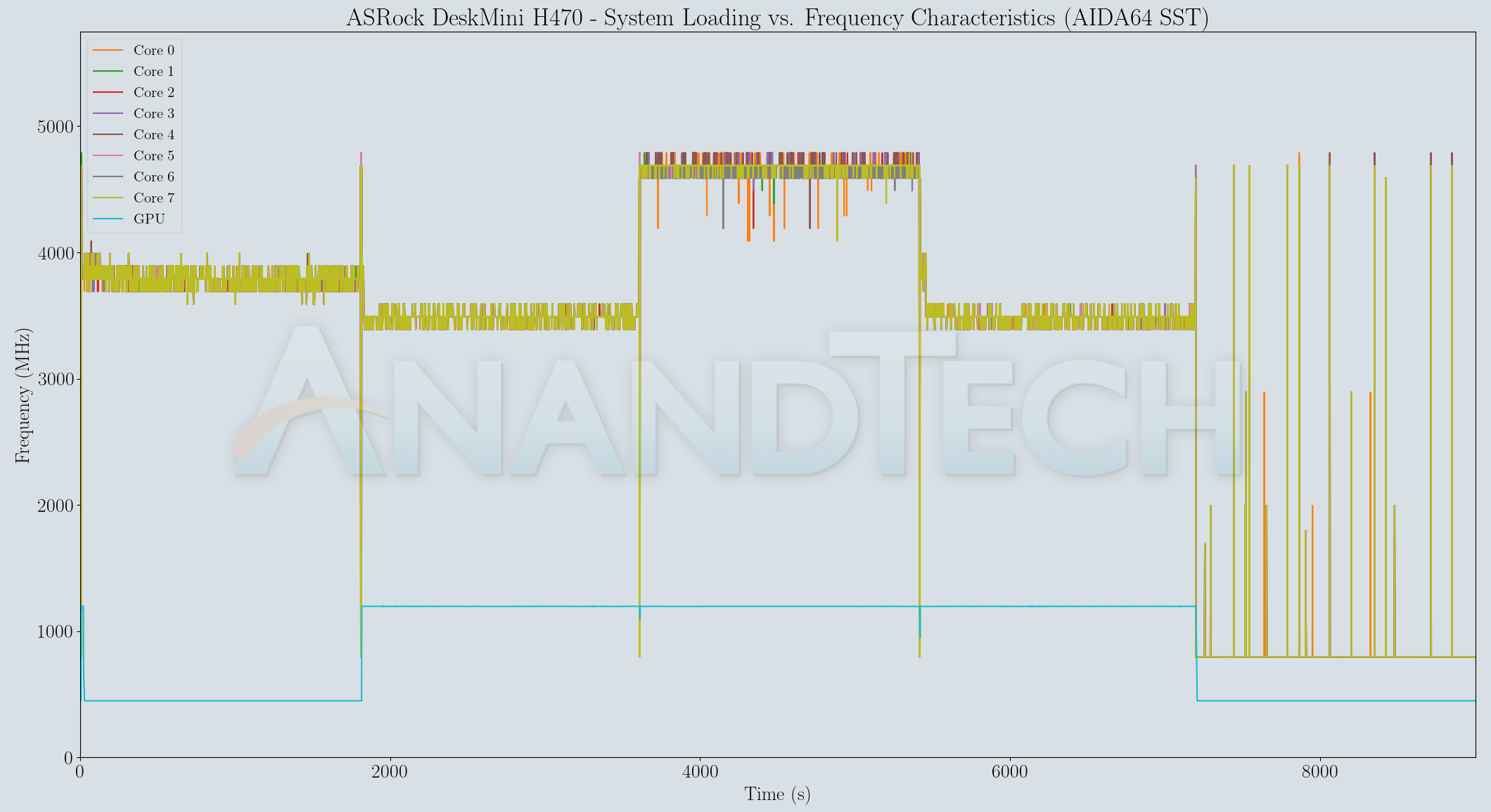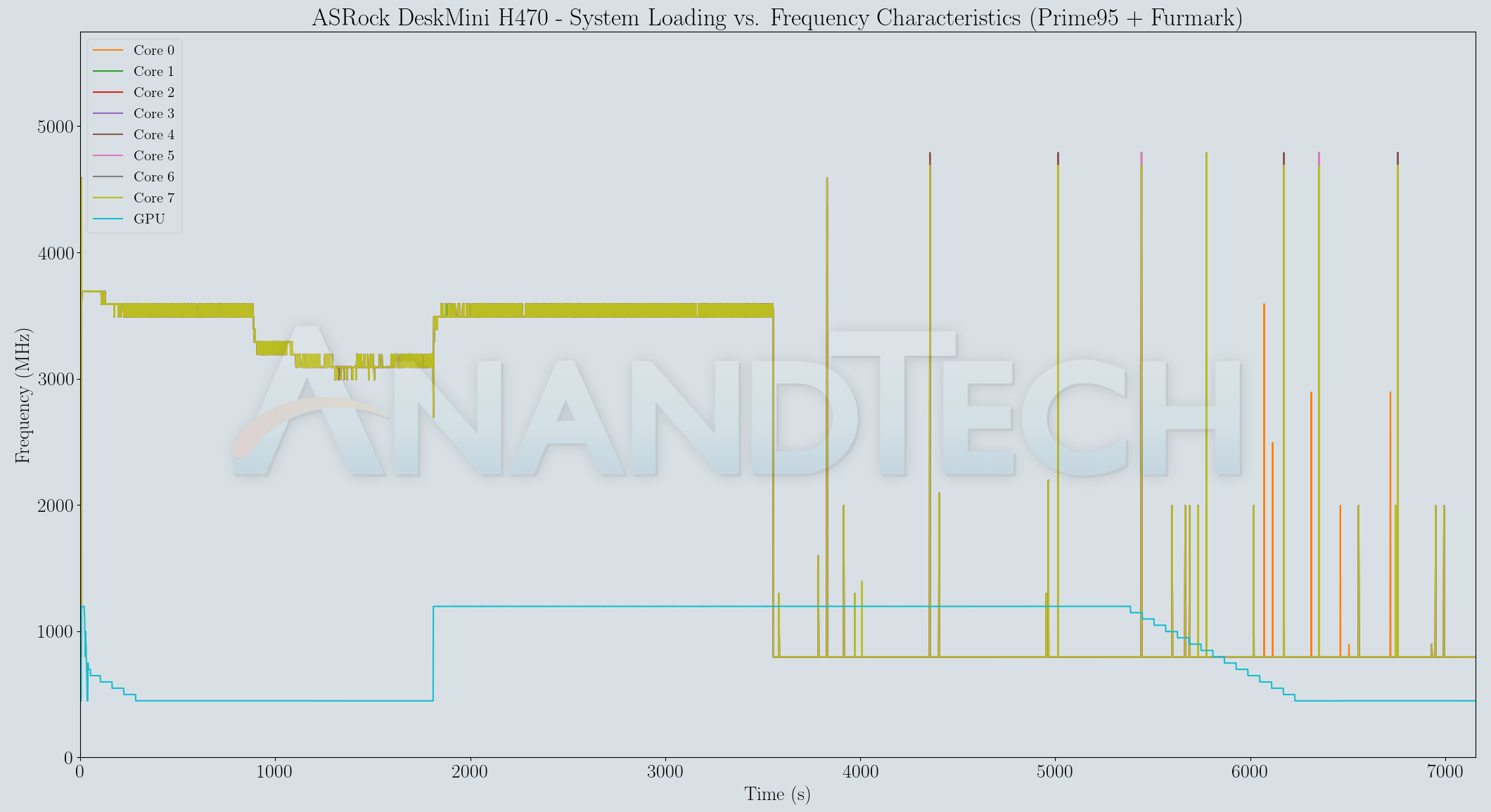ASRock DeskMini H470 Review: A No-Frills LGA 1200 mini-PC Platform
by Ganesh T S on December 29, 2020 8:00 AM ESTPower Consumption and Thermal Performance
The power consumption at the wall was measured with a 4K display being driven through the DisplayPort port in non-HDR mode. In the graphs below, we compare the idle and load power of the ASRock DeskMini H470 with other low power PCs evaluated before. For load power consumption, we ran the AIDA64 System Stability Test with various stress components, followed by our custom stress test (Prime95 and Furmark) and noted the maximum power consumption at the wall.

The idle power consumption can be classified into two sets - systems equipped with discrete GPUs idle at 25W+, while ones without idle aroud 10W+ lesser. Compared to other dGPU-less systems, the DeskMini H470 leads the idle numbers at 15W. On the load side too, we see it at the top of the charts in its class thanks to Intel's efforts to get as much performance as possible with suitable PL1 and PL2 numbers for its Comet Lake-S processors as the system design might allow.
Our thermal stress routine starts with the system at idle, followed by four stages of different system loading profiles using the AIDA64 System Stability Test (each of 30 minutes duration). In the first stage, we stress the CPU, caches and RAM. In the second stage, we add the GPU to the above list. In the third stage, we stress the GPU standalone. In the final stage, we stress all the system components (including the disks). Beyond this, we leave the unit idle in order to determine how quickly the various temperatures in the system can come back to normal idling range. The various clocks, temperatures and power consumption numbers for the system during the above routine are presented in the graphs below.
| ASRock DeskMini H470 System Loading with the AIDA64 System Stability Test | |||

The system has no trouble keeping the package power at 65W - this is what the processor is rated for, and the DeskMini H470 configuration allows exactly that. Core clocks stay well above the rated 2.9 GHz for the most part and the GPU clock is steady during the course of the stress segments where the GPU is active. The Silverstone SST-AR11 heat-sink does wonders - the package temperature never crosses 65C! However, the absence of airflow to other components is an issue - the voltage regulators touch 100C and one of the SSD temperature sensors goes as high as 80C when the SSD is stressed.
| ASRock DeskMini H470 System Loading with Prime95 and Furmark | |||

In the custom stress test involving Prime95 and Furmark, the package power consumption stays at 65W for scenarios involving the CPU. However, when the GPU alone is stressed, the number falls down to a sub-30W value. This is not due to any thermal limitations, but just the nature of the iGPU in the Core i7-10700. The GPU clock stays at the rated 1200 MHz during the full GPU-loading segment. Core clocks are also above 2.9 GHz in the first two segments. The reason for the variation / push down of the core clocks around halfway through the Prime95-only scenario is because of the temperature of the voltage regulation circuit. It shoots up as high as 105C even when the cores themselves are at 60C only.
The DeskMini H470 configuration tested above has no problems with thermal limits on the processors thanks to the excellent performance of the Silverstone SST-AR11 heat-sink. However, the case design has limited airflow as there is no other fan to cool down the SSD and/or voltage regulating circuitry. Any performance limitations are due to the thermals associated with the VRMs. While the installed CPU can do work corresponding to its rated power consumption numbers / TDP, there may be limitations on trying to extract the last bit of performance from the processor - an aspect that ASRock tries hard to deliver with features such as the 'base frequency boost' in the 'OC Tweaker' BIOS section.










26 Comments
View All Comments
ingwe - Tuesday, December 29, 2020 - link
What a great value! I am impressed.JfromImaginstuff - Tuesday, December 29, 2020 - link
Seems pretty darn goodAdditionalPylons - Tuesday, December 29, 2020 - link
I agree that this is great value. Shame about not including 2.5 GbE though. Ganesh, are you planning to review the AMD counterpart Deskmini X300 as well? (Despite being a bit older it still supports the latest Renoir APUs.) Personally I'm hoping for something like this based on Cezanne APUs to be launched at CES. It is great having socketed CPU in the Deskmini, but I'd also gladly buy a Cezanne-based successor to e.g. Asus PN50, Gigabyte Brix or ASRockInd 4x4box.powerarmour - Tuesday, December 29, 2020 - link
Yep, not surprised it's the 'Intel' variant here...lmcd - Tuesday, December 29, 2020 - link
As a 2400G user, it makes sense why they didn't review it. It's dated.And Ian is the one that has the OEM-only APUs.
ganeshts - Tuesday, December 29, 2020 - link
I have a DeskMini X300 sample that arrived just a few days back along with a Renoir APU. Review should be out sometime in January.AdditionalPylons - Tuesday, December 29, 2020 - link
Great! Looking forward to that! And thanks a lot for this review as well!osteopathic1 - Tuesday, December 29, 2020 - link
How would this compare to a new Mac Mini with M1?At the same price point the mac has less ram/storage but does have an arguably more powerful processor and HDMI 2.0 for 4K at 60Hz.
The internal storage is likely not a factor anyway as most who use this as a HTPC will have external storage of some sort with their media on it.
Any thoughts?
fishingbait15 - Thursday, December 31, 2020 - link
Huh? With the exception of single core performance, the M1 chip isn't "arguably more powerful" than any hexacore or octacore Intel desktop chip. Most media and "tech" sites only compare the M1 to the dual and quad core "mobile" (more accurately laptop) chips that Apple replaced in the MacBook Air and entry level Mac Mini and MacBook Pros. The hexacore and octacore desktop chips are clearly more powerful, and it was that CPU that was used here. And with 16 GB of RAM instead of 8 GB that is in the $699 Mac Mini, the comparison favors this device even more.Further, I do not know if you missed it but this configuration has a pair of 4K displayports at 60Hz as well as a third 4K output at 30Hz and a 4th lower resolution output.
Most people will use this as a HTPC? Speak for yourself. It would work just fine for general purpose computing, and you can get an entry level graphics card to make it suitable for 1080p gaming for under $100. (Meanwhile the ARM CPU will make macOS even worse for gaming than before). The M1 Mac is a great accomplishment, and as a result we will see more ARM-based Windows, ChromeOS and Linux laptops starting maybe in late 2021 when hopefully SOMEONE will come out with a design that includes at least 2 Cortex X1 cores, or failing that more than 4 Cortex A78 cores. But devices like this are precisely why Wintel will continue to have a clear majority of the market.
wpcoe - Tuesday, December 29, 2020 - link
It looks like the motherboard tray is a solid piece of metal closely beneath the M.2 slot. How is the heat dissipation for an M.2 SSD?